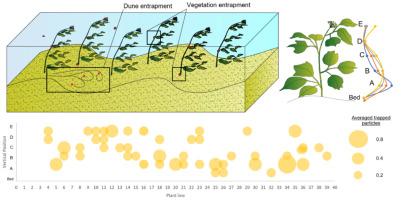作为天然屏障的河岸植被:植被河段中塑料颗粒滞留的实验分析
Q2 Environmental Science
引用次数: 0
摘要
塑料污染是一个日益严重的环境问题,河流是塑料颗粒进入海洋生态系统的重要途径。在河流廊道,河岸植被已被确定为塑料颗粒在下游运输时的潜在天然屏障。捕获动力学的知识似乎是理解河岸屏障在减轻塑料污染中的作用的基础。然而,迄今为止,还没有研究过河岸柔性植物叶片分布和湍流对塑料颗粒滞留动力学的影响。这项工作旨在填补这些知识空白,包括颗粒特性(即密度、大小和形状)和植被结构(即枝叶数量)的影响。实验室实验在固定的沙丘床上的稳定流动条件下进行,使用刚刚淹没的柔性叶状塑料植物。结果表明,颗粒滞留率受密度和形状的影响较大。在测试的圆盘状颗粒中,密度较高的颗粒(1.4 g/cm³)的保留率高达93%,主要集中在河床结构上。在相同密度(1.04 g/cm³)下,不规则颗粒的保留率几乎是圆盘状颗粒的两倍(20% vs. 9 - 10%),垂直分散受湍流影响。湍流动能(TKE),表示为无因次TKE/U²值,显示出与保留率的非线性关系:低于~ 0.0015的值与增强的捕获有关,而更高的湍流降低保留率,可能是通过促进再悬浮和减弱颗粒粘附。TKE/U²的垂直剖面随叶片构型的变化而变化,表明植被结构调节了冠层湍流强度。这些发现为评估植被河岸带微塑料捕获效率提供了一个定量框架,为减轻水生系统中的塑料污染提供了基于自然和工程的解决方案。本文章由计算机程序翻译,如有差异,请以英文原文为准。

Riparian vegetation as a natural barrier: experimental analysis of plastic particle retention in a vegetated reach
Plastic pollution is a growing environmental concern, with rivers acting as critical pathways for plastic particles entering marine ecosystems. In river corridors, riparian vegetation has been identified as a potential natural barrier for plastic particles while transported downstream. Knowledge of the trapping dynamics appears fundamental for understanding the role of riparian barriers in mitigating plastic pollution. However, to date the effects of the foliage distributions of riparian flexible plants and of turbulence on the plastic particle retention dynamics have not yet been studied. This work aims to fill these knowledge gaps including also the influence of the particle characteristics (i.e., density, size, and shape) and of the vegetation structure (i.e., number of branches and leaves). Laboratory experiments were performed in steady flow conditions over a fixed dune bed, using just submerged flexible foliated plastic plants. Results show that particle retention is highly influenced by density and shape. Among the tested disk-shaped particles, those with higher density (1.4 g/cm³) exhibited retention rates up to 93 %, largely at the channel bed structures. At equal density (1.04 g/cm³), irregular-shaped particles were retained at nearly twice the rate of disk-shaped ones (20 % vs. 9–10 %), with vertical dispersion influenced by turbulence. Turbulent Kinetic Energy (TKE), expressed as dimensionless TKE/U² values, showed a non-linear relationship with retention: values below ∼0.0015 were associated with enhanced trapping, while higher turbulence reduced retention, likely by promoting resuspension and weakening particle adhesion. Vertical profiles of TKE/U² varied with leaf configuration, suggesting that vegetation structure modulates turbulence intensity along the canopy. These findings provide a quantitative framework to evaluate microplastic trapping efficiency in vegetated riparian zones, offering insights into natural and engineered nature-based solutions for mitigation of plastic pollution in aquatic systems.
求助全文
通过发布文献求助,成功后即可免费获取论文全文。
去求助
来源期刊

Environmental Advances
Environmental Science-Environmental Science (miscellaneous)
CiteScore
7.30
自引率
0.00%
发文量
165
审稿时长
12 weeks
期刊介绍:
 求助内容:
求助内容: 应助结果提醒方式:
应助结果提醒方式:


